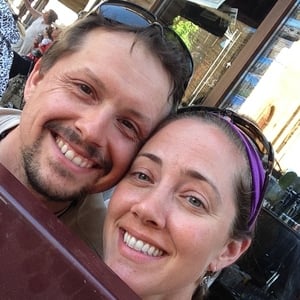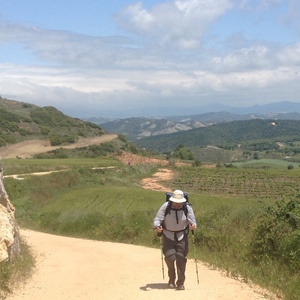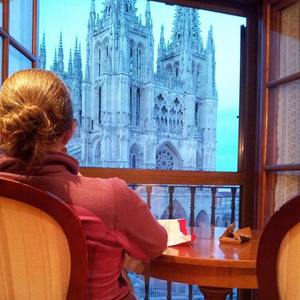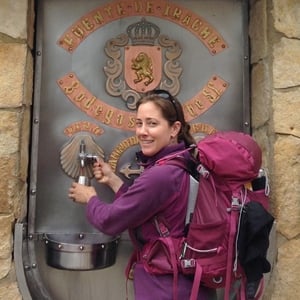Elizabeth & Kendall
We had walked 279 miles toward Santiago de Compostela, traveled 497 miles total across Northern Spain, spent 25 days away from home, wandered through 4 regions and 7 provinces, endured numerous blisters - and we were almost there.
“Clink-clank, clink-clank,” the tips of our walking poles tapped the pavement as we hobbled along the street toward our final destination. My gaze shifted from my new husband, to the horizon, and back again. I expected to see it any minute -- the thing we had walked toward for the past 25 days -- and I was filled with anticipation. Tearful, proud, excited, tired. This would be our first sighting of the cathedral of Santiago de Compostela, and I imagined that once we crested the hill we would see it sitting in the valley below, with grand spires towering over the surrounding city.
On May 25th, 2014, we had celebrated our marriage just outside of Seattle, Washington, surrounded by family and friends. The next day we had departed for Europe, and after a brief stop in Paris, then a high-speed train to Bayonne, we had eventually reached St. Jean Pied de Port, where our walking journey would begin. The night before our on-foot departure we had feasted on a French meal of red wine, olives, soft cheese, greens, bread, and Jambon de Bayonne. We had soaked in the physical comforts that surrounded us, anticipating the following morning when we would don our 20+ pound backpacks and set off on foot to conquer our first challenge: the Pyrenees.
Munching on gummy fish that first morning of walking, we had ascended the mountainous path surrounded by mist. Tired and aching, this first day had truly been a challenge as we had made our way up-up-up. “Where is the top?” we had mumbled in turn. “Here it is, I think this is it,” we had repeatedly said, only to find a steeper incline around the bend. We had placed one foot in front of the other as we crossed from southern France into northern Spain, and we had given each other the necessary space to focus on our own progress, while at the same time checking in on the welfare of our new spouse.
How had we chosen the Camino for our honeymoon? The idea had surfaced on one of our earlier date nights, shortly after our engagement. We had dated for just a little more than a year, but both Kendall and I had wanted to travel the Camino Frances to Santiago de Compostela for years, and for us the idea of a walking adventure had rung truer than a journey to a tropical paradise. That evening I had looked at Kendall and said “Let’s have a wedding with family and friends, and then walk the pilgrimage in Northern Spain as the beginning of our journey together as a married couple.” “Sounds great,” he had said.
A few months later we had found ourselves on the slopes of the Pyrenees at the beginning of our honeymoon pilgrimage, just a few short days after becoming husband and wife.
Many say that when you embark on a pilgrimage, you are beginning a journey of change. On May 26th Kendall and I had begun two pilgrimages. One - we had started our marital adventure together – a pilgrimage that would last for decades and most certainly take us in new directions. Two - we had also begun our month-long trek from southern France through northern Spain, and would eventually emerge from the abbreviated journey with refined tools that would help us navigate life as a married couple.
After tackling the Pyrenees that first day of our pilgrimage, we had arrived in Roncesvalles, Spain, with sore bones, swelling feet, and weary selves. We had checked into our hotel and soaked in warm showers, following them with a fabulous menu del peregrino and a glass of Spanish wine, then had collapsed into bed.
Many pilgrims on the Camino Frances choose to stay in Albergues, which are communal forms of lodging, known for their hospitality and sense of camaraderie. We had instead opted for hotel rooms, with comfortable beds and private bathrooms – allowing for time spent together as a honeymooning pair. We hadn’t made reservations in advance, which worked fine for us, as lodging was abundant and we were able to easily find places to stay along the way. Lucky for us, we were traveling in May and June, just before the summer pilgrims increased in number, and just before reservations became more of a necessity for them.
The days of our trip had continued in this manner: we woke in the morning, slathered on the sunscreen, filled water bottles, reassembled our packs, bandaged the newest blisters, ate a breakfast of cola-cao or zumo de naranja accompanied by some sort of postre, and possibly a few other goodies depending on the spread. Then we’d collected our walking sticks and set off for the day.
We had indeed met numerous challenges as we walked on: a head cold for me on the second day, a sore knee for Kendall on the third, swarms of gnats, blazing sunny trails, throbbing legs, blistered feet and hands, a spouse needing a day of rest instead of the planned day of trekking, and the trial of coping with the unexpected death of a loved one back home.
The days of our Camino had also contained highs, relaxation, and fabulous times. We had detoured north and south to various significant sites. We had stood feet away from Paleolithic handprints painted onto the walls of prehistoric caves. We had toured 6th and 11th century monasteries, walked on and around ancient Roman roads and walls, stood on the sidelines during abbreviated runnings of the bulls, wandered through towering cathedrals and humble village churches, bathed in light filtering through centuries-old stained glass, and stood in front of works by famous Spanish artists such as Goya, Picasso, and Velazquez in renowned galleries of art. We had walked through fields of poppies, hills of sheep, narrow winding roads of older Spanish towns. We had passed under towering windmills, drank from fountains of both water and wine, ate tortilla and ensalada mixta, and stopped for meals of pintxos and tapas. We had explored Gaudi’s architecture, and ate chocolate on our hotel balcony, with the Cathedral of Burgos towering above. We had taken days off and soaked our strengthening bodies in warm bubbling spas, and spent one glorious day feasting solely on room service and Spanish television.
Our days had also consisted of compromise. We had opted to jump ahead by taxi or bus when necessary, so that we could allow our bodies to heal and preserve our time, ensuring that we would be able to walk the full final 71 miles from Sarria to Santiago de Compostela – the minimum distance one must travel to officially complete the Camino. We had walked longer days when we were up for it, shorter days when my feet or his would demand it. We had changed our airline reservations and moved up our departure date by 4 days so that we could return for the funeral back home. And we had taken turns leading the way along the paths, providing space for the other to lead or follow as needed. More often than not we had walked side by side.
As for the price tag, well, the total cost of the trip came to roughly $5500 with the cost of airfare at around $2000 for both of us. But it was worth it. Kendall knew this, and I knew this, and as we listened to the “clink-clank,” “clink-clank,” of our walking poles hitting the pavement on our final day of walking, the end of our first pilgrimage came into view.
We had already dipped down into the valley, we had already ventured a good ways into town. Our 497 mile journey had evolved along a path unexpected and previously unknown, and it had become something much more meaningful and full than we had anticipated. As we rounded the corner into the plaza after walking 279 of the miles, we finally saw the spires of the cathedral of Santiago de Compostela towering above us. We hobbled up to it -- the grand monument that marked the end of our 25-day journey, a milestone that would wave goodbye to us as we traveled onto Madrid the next day, and then very soon, onto Seattle where we would continue our second, much longer pilgrimage. We were thankful we still had a pilgrimage to look forward to - the pilgrimage we had already commenced as husband and wife back home.





